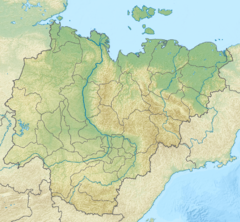| Kyuyol-Yuryakh Кюёль-Юрях / Күөл-үрэх | |
|---|---|
 Course of the Kyuyol-Yuryakh with lake Soluntakh at the center of the basin | |
Mouth location in Yakutia, Russia | |
| Location | |
| Country | Russia |
| Physical characteristics | |
| Source | |
| • coordinates | 71°55′50″N 141°51′07″E / 71.93056°N 141.85194°E |
| Mouth | Usun-Ulakh-Tubata |
• coordinates | 71°37′15″N 144°13′48″E / 71.62083°N 144.23000°E |
• elevation | 4 metres (13 ft) |
| Length | 247 km (153 mi) |
| Basin size | 2,330 km2 (900 sq mi) |
The Kyuyol-Yuryakh (Russian: Кюёль-Юрях; Yakut: Күөл-үрэх, Küöl-ürex) is a river in the Sakha Republic (Yakutia), Russia. It has a length of 247 kilometres (153 mi) and a drainage basin area of 2,330 square kilometres (900 sq mi).[1]
The river flows north of the Arctic Circle, across territories of the East Siberian Lowland in Allaikhovsky District. It flows across Soluntakh, the largest lake in the area. There are no settlements along its course.[2][3] The name of the river comes from the Yakut "Kuöl/urekh" (Күөл-үрэх), meaning "lake/river".[4]
Course
The Kyuyol-Yuryakh has its sources in a small lake of the northern end of the Yana-Indigirka Lowland, to the east of the Muksunuokha basin. The river heads first roughly southwards across a tundra area marked by permafrost and numerous small lakes. After a stretch it bends and flows in an ESE direction until it meets the western shore of lake Soluntakh, forming the primary inflow of the relatively large lake. The Kyuyol-Yuryakh then flows out of the lake from the eastern shore, meandering strongly in a ENE direction for a stretch, after which it turns southeastward to the north of the course of the Uryung-Ulakh, the main tributary of the Khroma. Finally it ends in lake Usun-Ulakh-Tubata (Усун-Уулаах-Тубата), entering it from the northwest.[2][3]
Tributaries
The main tributary of the Kyuyol-Yuryakh is the 77 km (48 mi) long Balyktakh-Yuryakh (Балыктаах-Юрэх) on the right. There are over 800 lakes in the basin, totaling an area of 129 km2 (50 sq mi). The river is frozen between early October and mid June.[2][5][1]
See also
References
- ^ a b "Река Кюёль-Юрэх in the State Water Register of Russia". textual.ru (in Russian).
- ^ a b c "R-55_56 Topographic Chart (in Russian)". Retrieved 30 May 2022.
- ^ a b Google Earth
- ^ Leontiev V.V. , Novikova K.A. Toponymic dictionary of the North-East of the USSR / scientific. ed. G. A. Menovshchikov ; FEB AS USSR . North-East complex. Research Institute. Lab. archeology, history and ethnography. - Magadan: Magadan . book. publishing house , 1989. — ISBN 5-7581-0044-7
- ^ nature.ykt - Кюёль-Юрях
External links
- Fishing & Tourism in Yakutia
- Закон Республики Саха (Якутия) от 30.11
- Map showing survey route followed during the current study of Siberian cranes

